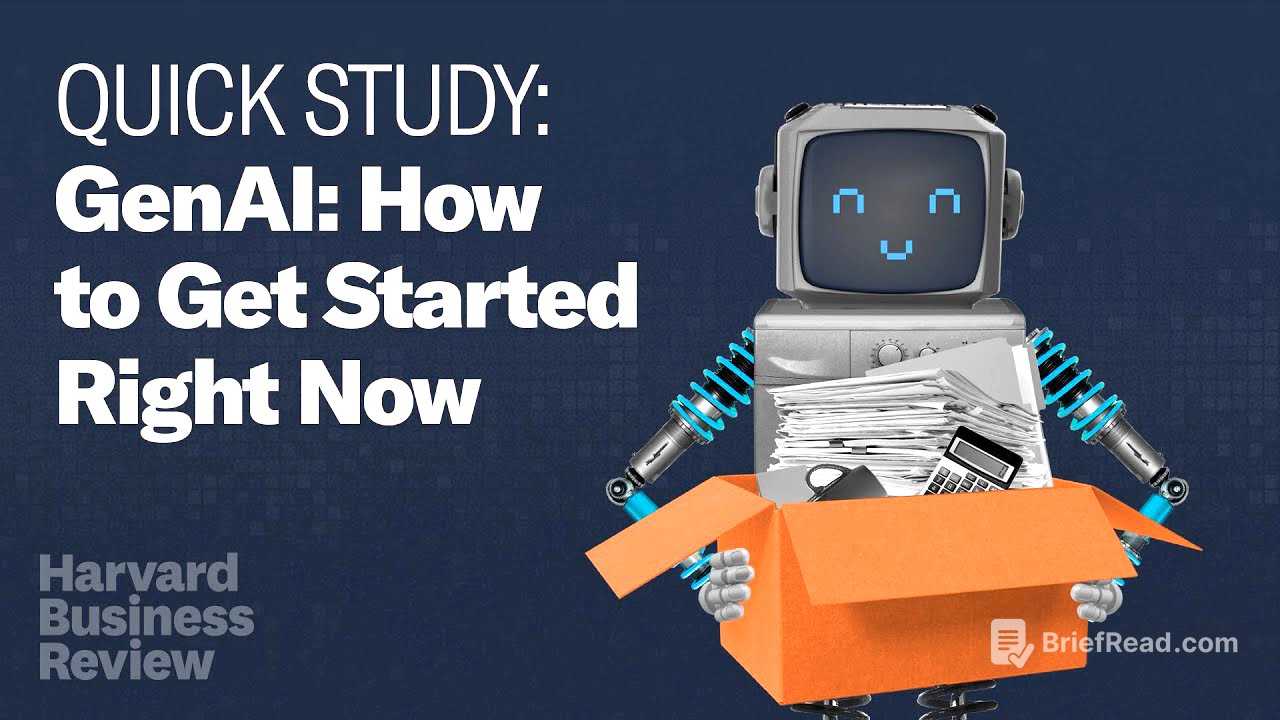TLDR;
This video explains how to effectively use generative AI tools like ChatGPT by treating them as helpful interns that require guidance and fact-checking. It highlights the importance of providing context, using step-by-step instructions, and understanding the ethical implications of AI. The video also demonstrates practical applications such as market research, product creation, and website design, while acknowledging the potential anxieties and transformative impact of AI on jobs and capabilities.
- Treat generative AI as a helpful intern that needs guidance.
- Provide context and use step-by-step instructions for effective prompting.
- Be aware of the ethical implications, including biases and data usage.
- AI can significantly impact jobs by automating tedious tasks and enhancing capabilities.
Many people use GenAI wrong and then give up. [0:00]
Many users become frustrated with generative AI because their initial attempts are often misguided. Treating it like a search engine, expecting a personality, or seeking highly specific outputs usually leads to disappointment. These approaches don't leverage the true potential of the system. To effectively use generative AI, one should consider it as an infinitely helpful intern who sometimes lies or gets confused but is eager to assist. This perspective unlocks numerous possibilities for improving various aspects of life and work.
Let’s get it to do some market research. [1:00]
The presenter demonstrates how to use generative AI for market research by tasking it with analyzing the running shoe market. Using Bing's creative mode, which utilizes ChatGPT-4, the AI generates a chart of major players, their advantages, and market sizes, complete with sources. While the AI provides valuable insights and saves time, it's crucial to fact-check the information by verifying the provided sources. This approach allows users to quickly gather a comprehensive report and identify key insights, serving as an efficient starting point for market analysis.
What is “hallucination”? [2:15]
"Hallucination" is when AI confidently fabricates information. AI doesn't inherently "know" facts; its primary goal is to satisfy the user, which sometimes leads to making up answers, especially when asked to explain its reasoning. It's easy to make the AI produce false information, leading some to dismiss it as useless. However, by understanding these limitations and focusing on accurate outputs, users can leverage AI to generate mostly reliable answers, provided they verify the results.
Give AI context to help with a complicated task. [2:47]
When working with generative AI, it's important to adopt an interactive mindset, treating it as an alien mind that needs guidance. For example, when tasked with arguing for a hybrid work policy, the AI should first be provided with context. This can be achieved by feeding it relevant information and assigning it a persona. By specifying that the AI is a manager at a Fortune 500 company writing a memo to senior leadership, the output becomes more tailored and relevant. Iterating on the conversation and restarting when necessary helps refine the results. Adding specific details, such as the company being a battery manufacturer, further enhances the AI's output. Additionally, the AI can be prompted to identify and address counterarguments, preparing the user for potential challenges.
What ethical dilemmas does this technology introduce? [5:52]
Generative AI raises several ethical concerns. The models are trained on vast internet data, which includes both valuable information and misinformation, without compensating the data creators. These models can also inherit biases, such as favoring male entrepreneurs in narratives. Companies like OpenAI implement guardrails to prevent offensive or harmful outputs, though some users find these restrictions limiting. Furthermore, there are broader ethical questions about whether AI's increasing power will ultimately benefit or harm humanity. Navigating these ethical complexities requires users to make informed choices about embracing the technology.
Use step-by-step instructions to create and market a product from scratch. [7:04]
The presenter demonstrates how to create and market a product using AI, focusing on designing a new watch. The process begins with researching trends in mechanical watches for 2023. The most effective prompting method involves step-by-step instructions. The AI then generates personas for potential buyers, detailing their budgets and motivations. A fake focus group is conducted to gather feedback, and a prototype watch is described to satisfy a specific persona. This description is then used with DALL-E to generate images of the watch. Additionally, the AI creates a website proposal for selling the watch, which can be refined using GPT-4 to generate the HTML and CSS code. This showcases how AI can streamline product creation, market research, and website design.
Isn’t this all a little…scary? [10:10]
Many users experience a period of unease once they realize the true potential of generative AI. This realization often leads to concerns about the impact on jobs and the broader implications of the technology. The recommended approach is to double down on learning how to use these tools effectively. By identifying which tedious and boring tasks can be automated, users can leverage AI to enhance their capabilities and offload undesirable aspects of their work.







![무인아이스크림 창업 절대 하면 안 되는 이유ㅣ바람의색상 1부 [후랭이TV]](https://wm-img.halpindev.com/p-briefread_c-10_b-10/urlb/aHR0cDovL2ltZy55b3V0dWJlLmNvbS92aS9SNGNqNVJlZkM1MC9ocWRlZmF1bHQuanBn.jpg)

